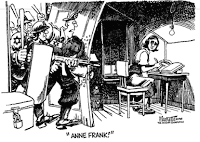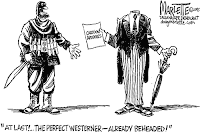 In early July, at the age of 57, Pulitzer Prize-wining illustrator and editorial cartoonist Doug Marlette was killed in a car accident in Mississippi. As fans of Marlette's work, and students of visual communication, we wanted to take a moment to remember...
In early July, at the age of 57, Pulitzer Prize-wining illustrator and editorial cartoonist Doug Marlette was killed in a car accident in Mississippi. As fans of Marlette's work, and students of visual communication, we wanted to take a moment to remember...Marlette won his Pulitzer in 1988 for cartoons he drew for the Atlanta Constitution and the Charlotte Observer. He also worked at New York Newsday and The Tallahassee Democrat, and wrote two novels. In addition to his work as a editorialist, Marlette was also the author and illustrator behind a Zen-master garage mechanic (Dub), a tobacco-chewing preacher (the Rev. Will B. Dunn), and other residents of a fictional Southern town called Bypass. His syndicated comic strip, Kudzu, offered what scholar John Shelton Reed calls an "idealized South."
At the time of winning his Pulitzer, Marlette said that his biting approach could be traced in part to "a grandmother bayoneted by a guardsman during a mill strike in the Carolinas. There are some rebellious genes floating around in me."
 Marlette was among the first to poke fun at Jim and Tammy Faye Bakker. Of his criticism of the televangelists, Marlette once said "I was into televangelists before televangelists were cool." Marlette, who grew up a Southern Baptist, said Jim Bakker used to call him a "tool of Satan." But Marlette, perhaps, had the last laugh. His Pulitzer entry included a controversial cartoon that depicted Jerry Falwell, who at the time was in charge of the PTL ministry, as the serpent in the Garden of Eden.
Marlette was among the first to poke fun at Jim and Tammy Faye Bakker. Of his criticism of the televangelists, Marlette once said "I was into televangelists before televangelists were cool." Marlette, who grew up a Southern Baptist, said Jim Bakker used to call him a "tool of Satan." But Marlette, perhaps, had the last laugh. His Pulitzer entry included a controversial cartoon that depicted Jerry Falwell, who at the time was in charge of the PTL ministry, as the serpent in the Garden of Eden.Of his trade, Marlette wrote in 2006: "The American cartoon was born in revolution. (The very first, designed by Ben Franklin, showed a snake cut into eight segments, each representing one of the colonies. The legend above it read "Join or Die.") The best political cartoons ... are always created in the spirit of the Prague Spring and the Velvet Revolution. They question authority, challenge the status quo and are inevitably accused of "Disturbing the Peace," borrowing the title of one of Václav Havel's books. If the editorial cartoons are doing their job, efforts will be made to suppress them."
 And, as you might expect, Marlette's was often of such inflammatory nature. Aside from his attacks on the PTL (which elicited a vicious counter-campaign from the Christian organization), of more notable controversial pieces were his often scathing criticisms of Israeli policy toward the Palestinians and his Southern-tinged views on the lingering crisis of American racism (including an infamous cartoon attacked by Chicago mayor Daley).
And, as you might expect, Marlette's was often of such inflammatory nature. Aside from his attacks on the PTL (which elicited a vicious counter-campaign from the Christian organization), of more notable controversial pieces were his often scathing criticisms of Israeli policy toward the Palestinians and his Southern-tinged views on the lingering crisis of American racism (including an infamous cartoon attacked by Chicago mayor Daley).But Marlette saved some of his most scathing commentaries for his own industry. Notably, he lampooned the New York Times for lacking the guts to hire an editorial cartoonist for its op-ed pages. Any self-respecting newspaper in a democracy, Marlette argued, had an obligation to use cartoons to convey its perspective and bring the subjects of its news coverage down to earth. If the Washington Post and the Los Angeles Times had Pat Oliphant and Paul Conrad, why didn't the newspaper of record have its own?
In a 2003 issue of Columbia Journalism Review, Marlette wrote on the outrage that at times surrounded his work: "We don't need the First Amendment to allow us to run boring, inoffensive cartoons. We need constitutional protection for our right to express unpopular views. If we can't discuss the great issues of the day on the pages of our newspapers fearlessly, where can we discuss them?"
In a like vein, Marlette infamously attacked the quisling journalists who apologized for the Danish cartoons of the prophet Mohammad. In a 2006 article for Salon.com, he wrote, "by caving in to fanatics over the Danish cartoons, the West has shown that it is not only gutless but brainless ... 'them damn pictures' ... have exposed not just the internal dynamics of what some have called Islamofascism but the corresponding corruption of our own values and character in the West. Our insides have been illuminated like an electrocuted Daffy Duck in an old Warner Brothers cartoon. And we now see what we're made of: not a lot of guts, or brains either."
 He goes on to say, "I can see little reason -- other than bodily fear, bottom-line self-preservation, and just poor judgment -- that the U.S. media and the public officials entrusted with defending our freedoms wimped out so thoroughly when challenged to live up to their historic obligation under the First Amendment to keep the American public informed. When we withhold information in the name of a misguided sensitivity, by default we allow nihilistic street mobs from London to Jakarta to define the debate in this country. In effect, we have capitulated to intimidation and threats and negotiated with terrorists. No need for Zarqawi to behead us. We do it ourselves."
He goes on to say, "I can see little reason -- other than bodily fear, bottom-line self-preservation, and just poor judgment -- that the U.S. media and the public officials entrusted with defending our freedoms wimped out so thoroughly when challenged to live up to their historic obligation under the First Amendment to keep the American public informed. When we withhold information in the name of a misguided sensitivity, by default we allow nihilistic street mobs from London to Jakarta to define the debate in this country. In effect, we have capitulated to intimidation and threats and negotiated with terrorists. No need for Zarqawi to behead us. We do it ourselves."This is not the first time that Fight.Boredom has addressed Marlette's work. Back in 2003, we took a look at the impact and emotional power of editorial cartoons. Then, we focused on the visual communication, in editorial illustration, of the 9/11 disaster, the resultant national malaise, and the loss of the space shuttle Columbia.
Part of that discussion included a reflection on the January 28, 1986 destruction of the space shuttle Challenger.
 The first editorial cartoon this author can remember is Doug Marlette's weeping bald eagle, furtively drawn for the afternoon edition of the Charlotte Observer. This simple but powerful reaction to the destruction of the Challenger is fixed in my mind even now, as rich in pen and ink detail as video of the blasted debris and veering SRBs are from that day's overwhelming news coverage. As a young boy, in love with space and overjoyed by the fortuitous timing of the Challenger's launch and my birthday, that devastating white explosion knocked my feet out from under me. If anything good came out of my first encounter with national tragedy, it might be found in Marlette's eagle. In that simple composition I understood the power of applied and thoughtful art. In that single tear, I got it.
The first editorial cartoon this author can remember is Doug Marlette's weeping bald eagle, furtively drawn for the afternoon edition of the Charlotte Observer. This simple but powerful reaction to the destruction of the Challenger is fixed in my mind even now, as rich in pen and ink detail as video of the blasted debris and veering SRBs are from that day's overwhelming news coverage. As a young boy, in love with space and overjoyed by the fortuitous timing of the Challenger's launch and my birthday, that devastating white explosion knocked my feet out from under me. If anything good came out of my first encounter with national tragedy, it might be found in Marlette's eagle. In that simple composition I understood the power of applied and thoughtful art. In that single tear, I got it.Thanks, Mr. Marlette.
